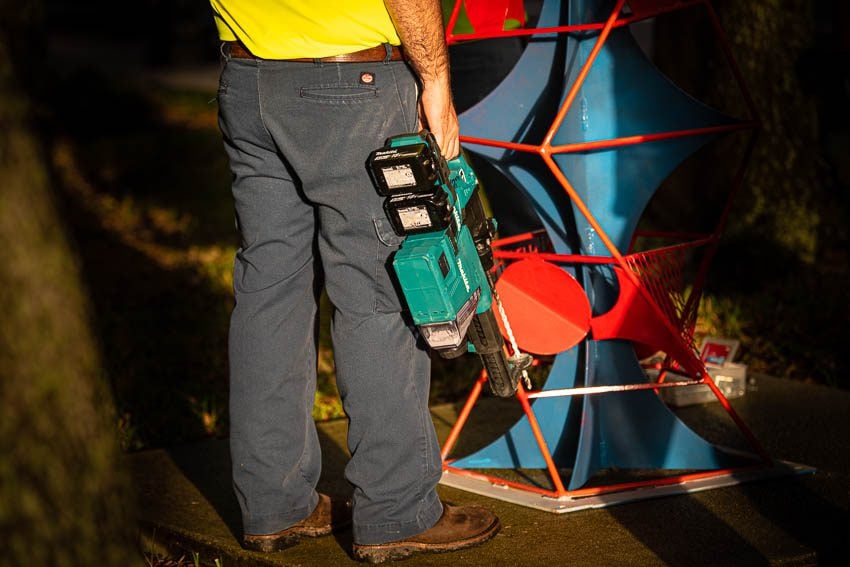Thirty years ago marked the first time I learned how to drill through concrete or masonry. I had to run microphone cables at my Dad’s church during college. The job required drilling a 1/2-inch hole through 12-inches of solid cast concrete. At the time, I only had my new Black & Decker 1/2-inch drill—a drill without a hammer feature. After 40 minutes of pushing as hard as I could, I finally broke through. A few weeks later I bought a Bosch 1/2-in hammer drill and it was a game-changer. Today I have multiple sizes of rotary hammer drills and hammer drills to handle a variety of situations and applications.
Table of Contents
- Hammer Drill vs Rotary Hammer Drill
- How to Drill Through Brick, Concrete, and Masonry Using a Hammer Drill vs Impact Driver
- Masonry Bits
- How to Drill Through Brick, Concrete & Masonry: Dust Collection
- How to Drill Through Brick, Concrete & Masonry – Techniques
- Cleaning Up After Drilling Through Brick, Concrete, and Masonry
- Buying vs Renting Equipment
- How to Drill Through Brick, Concrete, & Masonry – Summary
Hammer Drill vs Rotary Hammer Drill
Since some of the tool names might seem counterintuitive from what you might expect, let’s start by defining a hammer drill vs a rotary hammer. Whereas a hammer drill adds a vibrating mechanism to a standard drill, a rotary hammer uses an actual hammering/percussive mechanism to drive the bit forward and back in a more deliberate manner. Check out our linked article for more details on how each works.
Editor’s Note: When you buy your next drill, you may want to pay the extra few dollars and get the hammer drill model. , In the event you eventually need to drill into brick or concrete, it will be well worth it. From installing a Tapcon or inserting a few plastic anchors into a concrete wall, a hammer drill speeds up your workflow significantly over a drill.
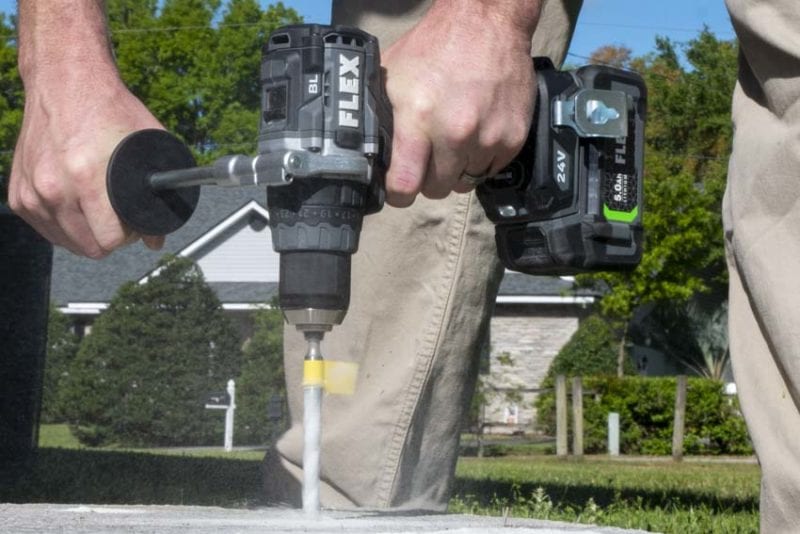
Only a rotary hammer lets you turn off the rotary movement and use the percussive motion alone. This is useful for using the tool with points or chisels for busting, carving, and scraping concrete and masonry. Of the two, rotary hammers drill through brick, concrete, and masonry much more rapidly. Also, note that putting a hammer drill into its hammering mode for materials other than concrete or masonry actually results in slower drilling.
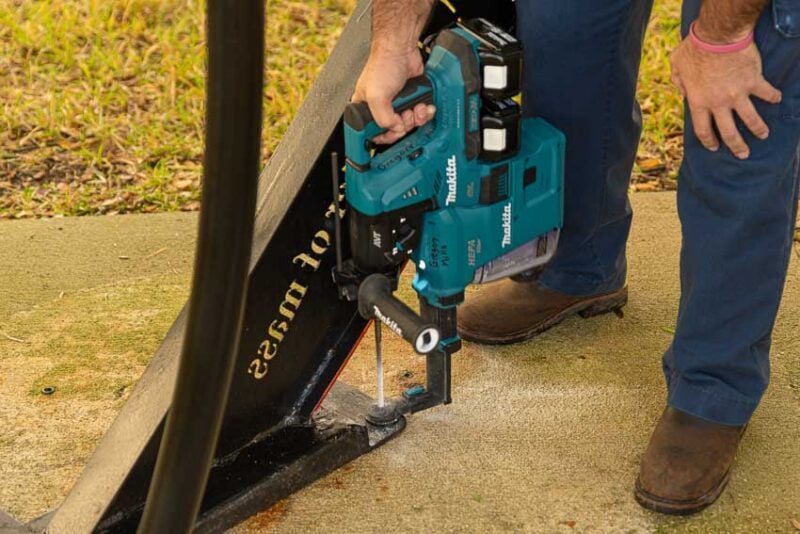
How to Drill Through Brick, Concrete, and Masonry Using a Hammer Drill vs Impact Driver
We often get asked about hammer drills vs impact drivers. While not specifically designed for drilling concrete, the percussive nature of an impact driver lets it drill into the concrete just as well as a hammer drill. In some cases, because of their potentially higher RPMs, they may even drill more quickly.
Impact drivers have a lot of factors that go into when they start impacting and when they start slowing down. This means the age and moisture of the concrete, the bits you are using, and the brand/model of impact driver affect the speed of your work. If you want to use your impact driver, DeWalt makes a good masonry bit set for them.
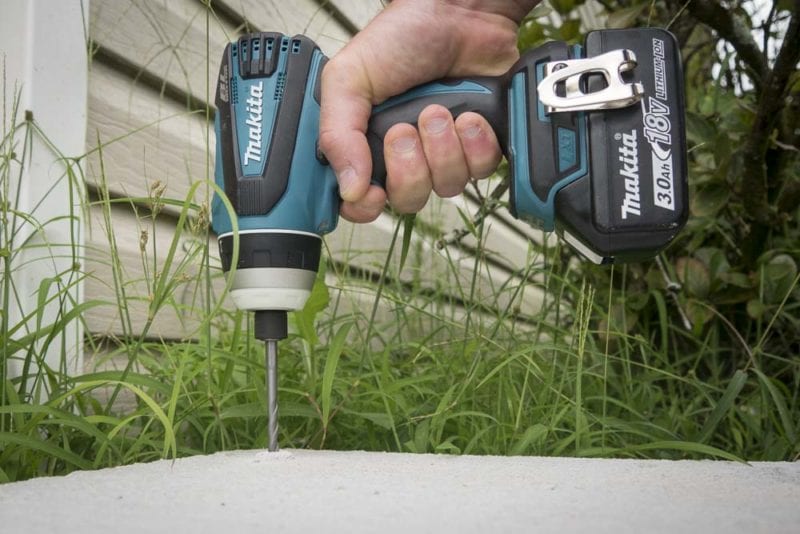
Masonry Bits
Masonry bits differ from bits used for wood, metal, or plastics in that they have carbide brazed onto the ends. This makes them easy to identify. The thicker the carbide, the more expensive the bit. The length of the bit is important too. I find a quality set of 6-inch bits such as the Bosch Blue Granite Set lasts a long time and should serve most people’s needs unless you need to go deeper or larger in diameter.
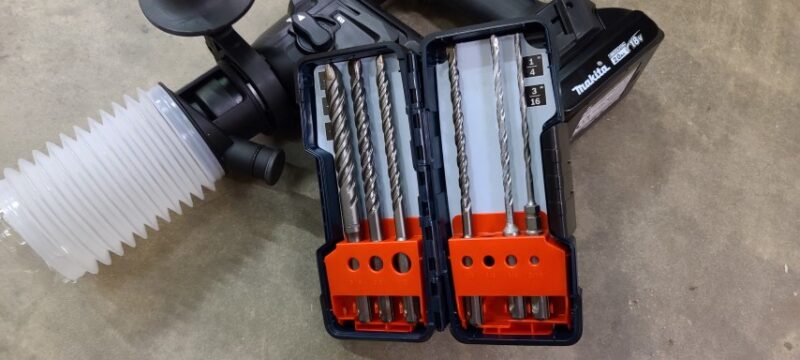
For the larger sizes though, I usually want to use a rotary hammer drill, not a hammer drill.
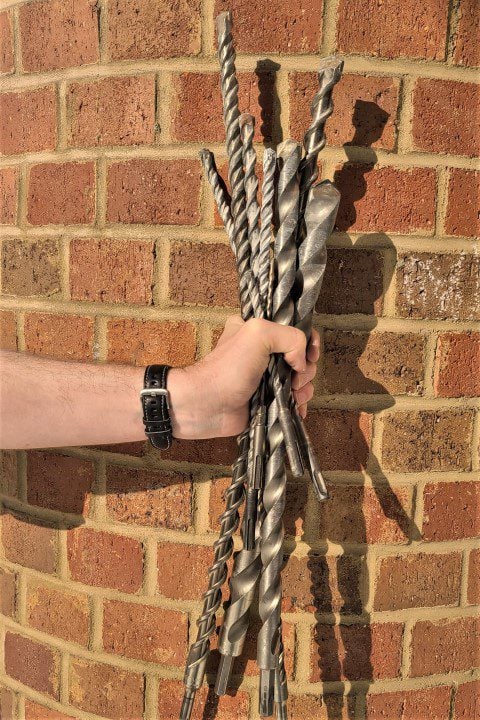
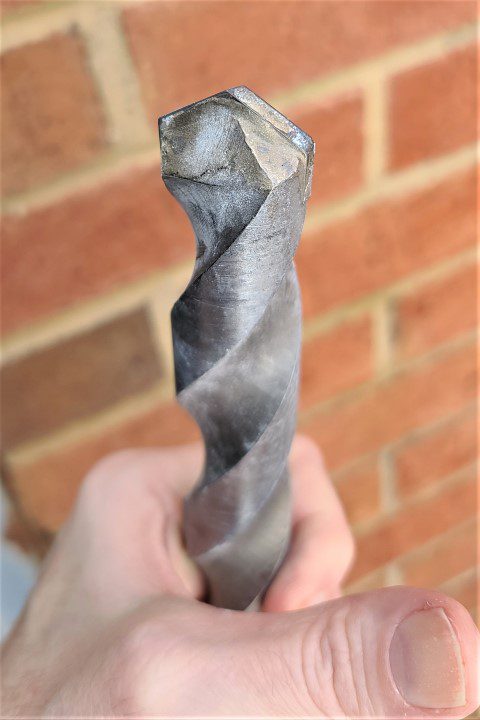
SDS & SDS Plus Bits
Rotary hammers do not use regularly masonry bits. To manage the extra torque they produce, these bits use a different chuck style called either SDS Plus (SDS+) or SDS Max (for larger applications). On the shank of the bit is an indentation that locks into place when you pull back the release on the chuck head. This makes it impossible for the bit to spin in the chuck or come loose like a regular drill’s Jacobs keyless drill chuck.
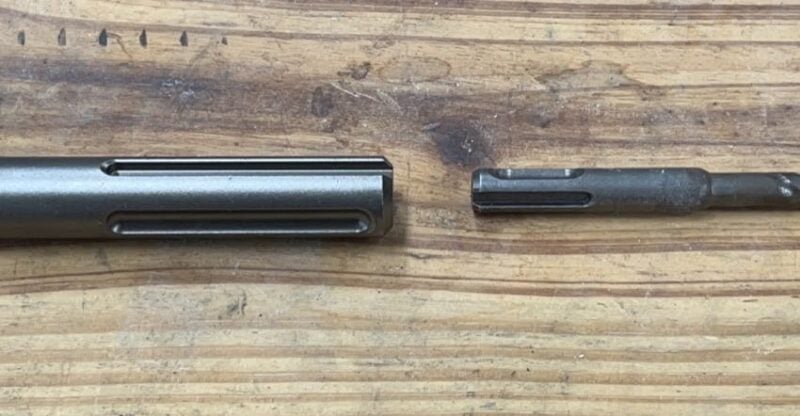
I recommend keeping a set of 6-inch SDS Plus bits up to a 1/2-inch diameter. You might also want to have a set of 12-inch long bits all the way up to whatever the largest diameter your rotary hammer will support. Though I occasionally need both 18-inch and 24-inch long SDS plus—I tend to buy those as needed. All of these bits have come in handy at one time or another when installing computer network cable or displays at the Polk Museum. I have also used then when installing outdoor sculptures.
Rebar Cutters
Most concrete features embedded steel reinforcement of some type. A small pad may simply use thin wire mesh. Anything thicker than a few inches probably includes rebar. If you hit rebar when drilling, you have two options. You can either drill a new hole in a different location or drill through the rebar. It takes a LONG time to drill through rebar using regular masonry bits. Fortunately, various manufacturers have created solutions for this. We like both the Bosch Rebar Cutters and the Diablo Rebar Demon SDS-Plus and SDS-Max bits for this. They last up to 7 times longer than a traditional concrete drill bit in these applications and are well worth the investment. Where the Bosch Rebar Cutters are meant to only cut rebar, the Diablo bits can be used as your primary cutter.
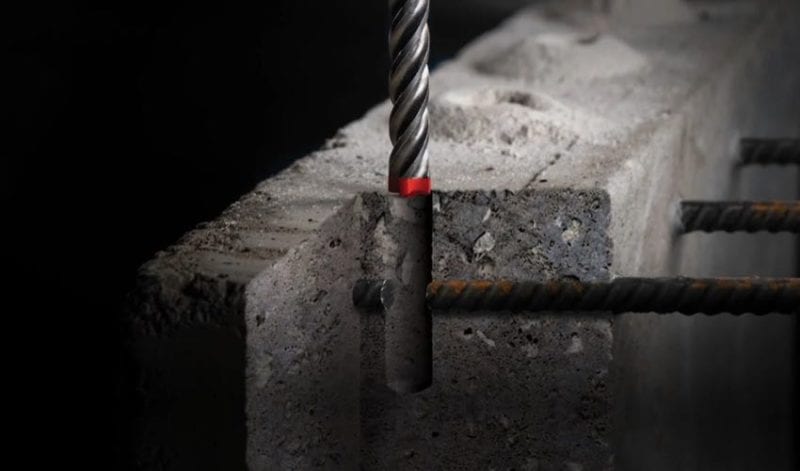
Core Bits
A core bit is like a hole saw for concrete. While you can drill small-diameter holes a few inches or less using a rotary hammer drill, larger holes require a different accessory. For these, you want to use large diamond core bits. These require a core drill big enough to handle the torque and weight of these bits. The Milwaukee MX FUEL Core Drill is basically a wall-mounted version of a drill press. It is cordless so it is expensive. Cheaper corded ones are available on Amazon for about $500. Just remember a 6-inch diamond core bit can also go for several hundred dollars. Often, you can rent these tools. Those in the trades who often need to drill large holes through concrete tend to buy these tools and keep them well-maintained.
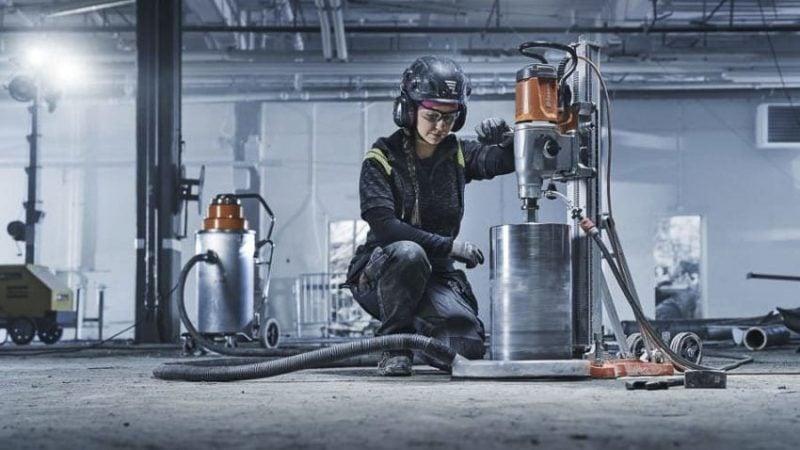
How to Drill Through Brick, Concrete & Masonry: Dust Collection
One of the problems with drilling into concrete and masonry is the presence of silica in the dust. Silica is a known carcinogen which means it is known to cause cancer. OSHA now mandates dust exposure levels. We have done an article to help you figure out how to get into compliance. Many new rotary hammer drills either come with a vacuum attachment for a dust extractor or have a dust extractor built-in.
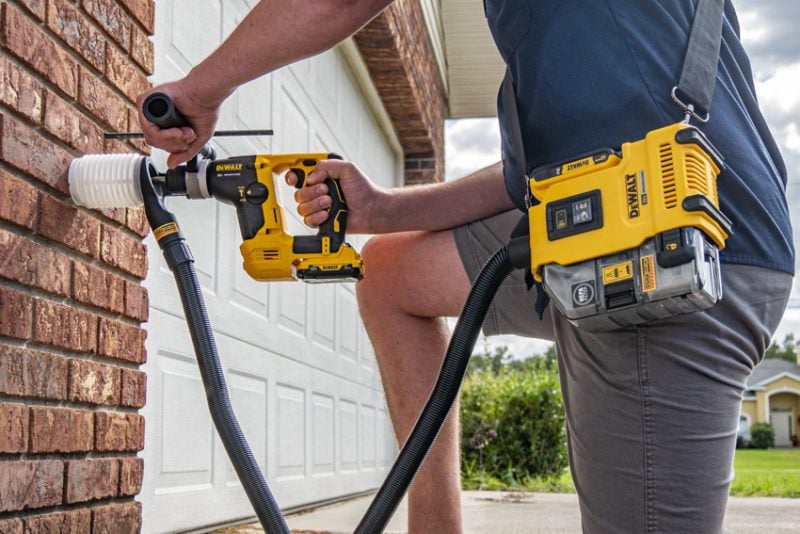
How to Drill Through Brick, Concrete & Masonry – Techniques
Regular Drill
If you need to drill into concrete with a regular drill (and no hammer feature) your best bet is to “accidentally” spill a drink inside the opening of the tool. Then, tell your significant other that you need to buy a new drill. This time get a hammer drill! In case your spouse is watching and you can’t do that, you have to do it the hard way. Push REALLY hard. As hard as you can without binding up the drill. Who knows, you may get lucky and burn out your drill motor!
OK, now let’s get serious.
If you feel like you get stuck, which can happen if you hit a piece of stone, pull the drill back a couple of inches and slam it forward while the drill is running at full speed. If you do this a few times you can hopefully crack the stone that is in your drill path. If you still feel like it is stuck, look at the drill bit tip. See if you see metal shavings. If you do, you likely hit some rebar. Start a new hole. And keep pushing hard!
Hammer Drill
Most people make one major mistake with hammer drills. They push way too hard. This is the opposite of a regular drill. If you push hard, you prevent the vibrating mechanism from doing its thing. You want to put just a moderate amount of pressure, but not enough that you can hear the tool slow down. Do this, and you’ll drill holes much more quickly. As a secondary benefit, not pushing too hard and letting the tool work extends your battery life.
Before I bought a rotary hammer, I regularly drilled up to 5/8-inch holes in concrete using a hammer drill. To drill holes that big, first drill 3/8-inch holes. We refer to this as a pilot hole. Then, use a 1/2-inch bit to expand the hole and remove more material. Finally, use a 5/8-inch bit to finish off the hole.
For the most part, we don’t recommend drilling holes larger than 1/2-inch in concrete with a hammer drill unless you have to. A rotary hammer does the job so much more quickly.
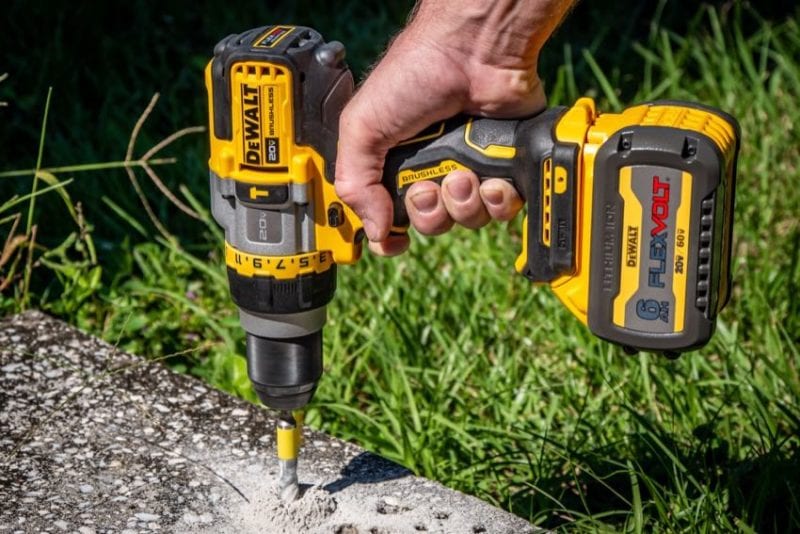
Rotary Hammer
You don’t really have to push down hard on a rotary hammer when drilling. The weight of the tool alone is often enough to drive it. You want the impact mechanism to be able to freely move back and forth without having to fight you in addition to the concrete. This is what makes rotary hammers seem to melt through the concrete so effortlessly. Your only job is to keep the bit at the correct angle. To help me stay perfectly centered, I use pilot holes when drilling anything larger than 5/8-inch in diameter.
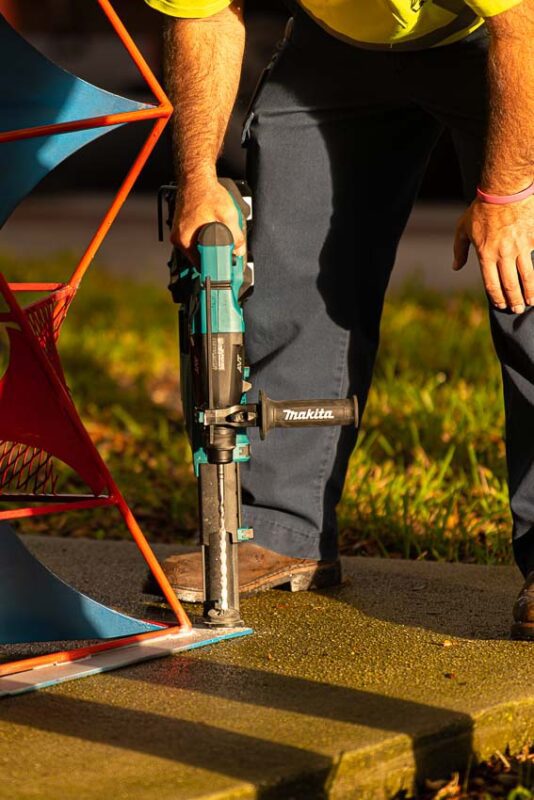
Cleaning Up After Drilling Through Brick, Concrete, and Masonry
After you drill your hole, do not blow it out. I used to keep an air bulb with my rotary hammer drill so I could blow out the hole without getting a face full of dust. Nowadays, OSHA requires the hole to be vacuumed out with a HEPA-rated dust extractor. Small cordless OSHA-compliant dust extractors are a huge help and should be on everyone’s shopping list.
Buying vs Renting Equipment
My personal opinion is that everyone should own a cordless hammer drill. Period. If you own a drill, it needs to be a hammer drill, not a regular drill. You never know when you will need to hang a hook on a cinderblock wall, install brackets for Christmas lights on brick, or screw down a mat to your garage floor.
If you work in the trades, you will probably need to buy a decent rotary hammer drill. Homeowners can usually get by renting a rotary hammer drill from their local rental center or Home Depot. Smaller rotary hammer drills are not that expensive. Often you can find a 7/8-inch rotary hammer drill (without battery) for less than $200. Many tradesmen buy a small rotary hammer for day-to-day use and rent the big ones only when they need to drill a huge hole.
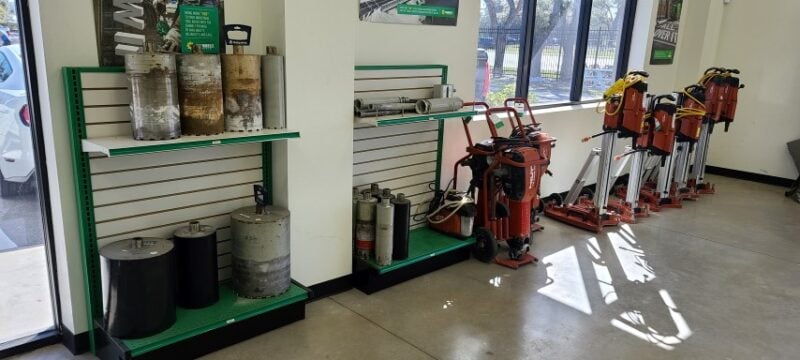
How to Drill Through Brick, Concrete, & Masonry – Summary
As long as you have the right drill type for the job and the correct bit, drilling concrete is not a difficult job. If you comply with OSHA dust regulations, drilling concrete is not nearly as messy as it used to be as either.

